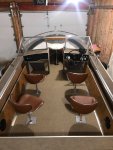for example, from a typical automotive technician curriculum
Automotive Technology Course Outline
Auto 110 – Automotive Introduction and Fundamentals (400 hours)
This course introduces the student to automotive industry standard practices including shop safety, use of chemicals, documenting repair estimates and work orders, identifying careers in the auto industry, and learning employability skills. Upon completion of this course, the student will understand and demonstrate proper work ethics in the automotive industry that meet standards to maintain employment eligibility. Students will become proficient with the use basic electrical testing equipment while testing batteries, fuses, DC motors, and other electrical circuits. Students will also learn how to apply Ohm’s law through diagnostic strategies. Students will be able to demonstrate the knowledge and ability to perform brake system diagnosis and repair to the hydraulic, mechanical, and anti-lock brake system. The student will correctly use and care for the tools and diagnostic equipment used while performing tasks, and observe safety procedures customary for the performance of these tasks. This course will prepare students for ASE certifications in the areas of electrical and brakes.
Auto 120 – Automotive Intermediate I (600 hours)
Students will learn preventative maintenance, service, and repair of automotive engines, heating and air conditioning, steering and suspension, automatic transmission, manual drivetrain and transaxles. This includes servicing the power steering fluid, transmission fluid, engine cooling system fluid, engine oil changes, and axle fluid. Students will also inspect and replacing steering & suspension components, diagnose and replace tires, perform wheel alignments, diagnose alignment defects, replace timing belts, gaskets, perform cylinder head and valve train diagnosis and repair, and lubricating system diagnosis and repair. This course ensures that students gain ability to perform the necessary diagnosis and repairs to the automatic transmissions, manual transaxles and drivetrains, and the heating and air conditioning system. The heating and air conditioning portion of this course will prepare the student for a mobile air conditioning system (MACS) Section 609 certification. This course will also prepares students for ASE certifications in steering and suspension, engine repair, heating and air conditioning, automatic transmissions, manual transaxles and drivetrain.
and the list goes on from there




















